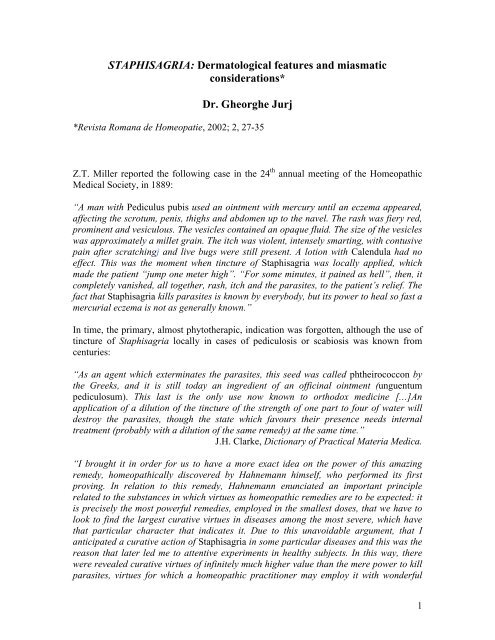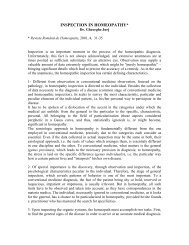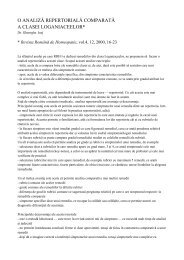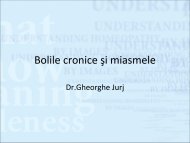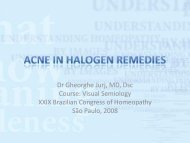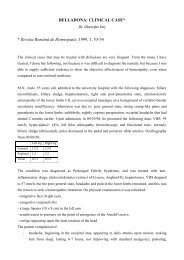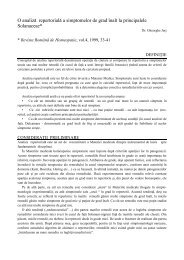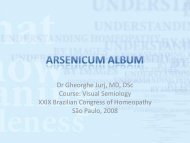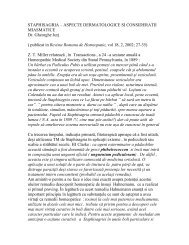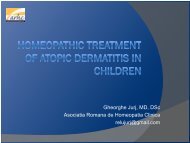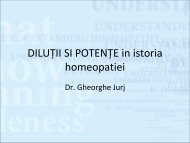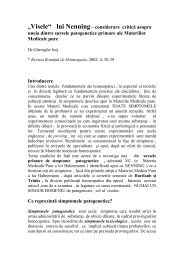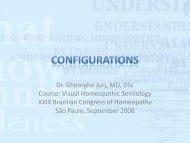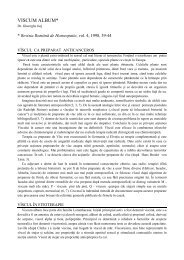STAPHISAGRIA - Dr. Gheorghe Jurj - Homeopatie
STAPHISAGRIA - Dr. Gheorghe Jurj - Homeopatie
STAPHISAGRIA - Dr. Gheorghe Jurj - Homeopatie
You also want an ePaper? Increase the reach of your titles
YUMPU automatically turns print PDFs into web optimized ePapers that Google loves.
<strong>STAPHISAGRIA</strong>: Dermatological features and miasmatic<br />
considerations*<br />
<strong>Dr</strong>. <strong>Gheorghe</strong> <strong>Jurj</strong><br />
*Revista Romana de <strong>Homeopatie</strong>, 2002; 2, 27-35<br />
Z.T. Miller reported the following case in the 24 th annual meeting of the Homeopathic<br />
Medical Society, in 1889:<br />
“A man with Pediculus pubis used an ointment with mercury until an eczema appeared,<br />
affecting the scrotum, penis, thighs and abdomen up to the navel. The rash was fiery red,<br />
prominent and vesiculous. The vesicles contained an opaque fluid. The size of the vesicles<br />
was approximately a millet grain. The itch was violent, intensely smarting, with contusive<br />
pain after scratchingj and live bugs were still present. A lotion with Calendula had no<br />
effect. This was the moment when tincture of Staphisagria was locally applied, which<br />
made the patient “jump one meter high”. “For some minutes, it pained as hell”, then, it<br />
completely vanished, all together, rash, itch and the parasites, to the patient’s relief. The<br />
fact that Staphisagria kills parasites is known by everybody, but its power to heal so fast a<br />
mercurial eczema is not as generally known.”<br />
In time, the primary, almost phytotherapic, indication was forgotten, although the use of<br />
tincture of Staphisagria locally in cases of pediculosis or scabiosis was known from<br />
centuries:<br />
“As an agent which exterminates the parasites, this seed was called phtheirococcon by<br />
the Greeks, and it is still today an ingredient of an officinal ointment (unguentum<br />
pediculosum). This last is the only use now known to orthodox medicine […]An<br />
application of a dilution of the tincture of the strength of one part to four of water will<br />
destroy the parasites, though the state which favours their presence needs internal<br />
treatment (probably with a dilution of the same remedy) at the same time.”<br />
J.H. Clarke, Dictionary of Practical Materia Medica.<br />
“I brought it in order for us to have a more exact idea on the power of this amazing<br />
remedy, homeopathically discovered by Hahnemann himself, who performed its first<br />
proving. In relation to this remedy, Hahnemann enunciated an important principle<br />
related to the substances in which virtues as homeopathic remedies are to be expected: it<br />
is precisely the most powerful remedies, employed in the smallest doses, that we have to<br />
look to find the largest curative virtues in diseases among the most severe, which have<br />
that particular character that indicates it. Due to this unavoidable argument, that I<br />
anticipated a curative action of Staphisagria in some particular diseases and this was the<br />
reason that later led me to attentive experiments in healthy subjects. In this way, there<br />
were revealed curative virtues of infinitely much higher value than the mere power to kill<br />
parasites, virtues for which a homeopathic practitioner may employ it with wonderful<br />
1
effects in rare morbid states, for which there does not exist any other remedy but this<br />
one.”<br />
Historically, the first uses of the remedy were diverse skin eruptions, genito-urinary,<br />
ocular and articular symptoms. These are the systems for which Staphisagria presents a<br />
true tropism and must always be kept in mind when this remedy is considered.<br />
More recently, the image of Staphisagria has been associated to keywords, all coming<br />
from the psychological domain, to reach a kind of caricature personality, “a soft person,<br />
psychically repressed by the husband or those around, unable to express her feelings or<br />
forced to repress them…” This kind of portraits, useful from a didactic standpoint,<br />
reflect only partially and mutilatedly the homeopathic reality of a remedy, which consists<br />
in the totality of symptoms it can elicit and cure. Each and all of the remedies has a<br />
bipolar action, and almost all may present contradictory traits. I believe that it is<br />
important to precise the clinical logic and to feel the tensions, motions, the apparent<br />
contradictions and the mode to solve them proper to each remedy, which we will find<br />
again in the internal tensions and motions of the patients. Every disease is an<br />
epiphenomenon, a mode to solve a dysfunction, internal or relating to the external world;<br />
in homeopathy, we find a model to solve it, because in this model – which necessarily<br />
subsumes all the symptoms of the patient – it is found the miracle of the remedy which<br />
certainly will be curative, according to the possibilities of each particular organism. Thus,<br />
besides the “soft Staphisagria” an “angry Staphisagria” exists, red or pale from anger,<br />
throwing and breaking objects, and a male remedy, for depressive men threatening to kill<br />
themselves with a gun, as well as for children whose teeth are destroyed upon appearing.<br />
Even if the initial suspicion arises from some mental symptoms, the confirmation may be<br />
wonderfully effected through the physical signs. It is not to think of some diseases but of<br />
particular traits, such as “Staphisagria skin” or “Staphisagria eyes” in order to confirm<br />
the choice of the remedy in a few seconds. In any situation, the skin is always present and<br />
may be of immense help to define a remedy. Staphisagria is one of the remedies that<br />
almost always is manifested in the skin in a way or another.<br />
Suppression - Expression<br />
Besides a physical tropism for a certain organ or system (eyes, skin, genito-urinary in this<br />
case), many remedies present a true situational tropism, e.g. mourning in Ignatia, bossstress<br />
in Nux vomica. At all levels, both psychological and physical, and more especially,<br />
in the skin, it exists in Staphisagria a basic polarity expressed in the binomium<br />
suppression – expression.<br />
At the psychological level, suppression is due to repressed emotions: anger – caused by<br />
the rudeness of those around or by abstention, a kind of ascesis (self-imposed,<br />
mortification) without any cause. What it must be stressed in the case of this remedy is<br />
that the suppressive events act at the causal level: they are the cause that determines the<br />
apparition of disease and disturbs. Thus, it will be found in rubrics such as “ailments<br />
2
from…”, which may be identified in the anamnesis through sentences like “Since…, I<br />
was never well again”.<br />
MIND - AILMENTS FROM - rudeness of others<br />
MIND - AILMENTS FROM – mortification<br />
MIND - AILMENTS FROM - mortification - indignation; with<br />
MIND - AILMENTS FROM – indignation<br />
MIND - AILMENTS FROM - excitement – emotional<br />
MIND - AILMENTS FROM – disappointment<br />
MIND - AILMENTS FROM - death of loved ones<br />
MIND - AILMENTS FROM - anger – suppressed<br />
MIND - AILMENTS FROM - anger - silent grief; with<br />
MIND - AILMENTS FROM - anger - indignation; with<br />
MIND - AILMENTS FROM – anger<br />
MIND - AILMENTS FROM - abused; after being – sexually<br />
However, the theme of “suppression” is much more extensive in Staphisagria, and might<br />
be referred to any suppression, even (or, especially) at the physical level. The first<br />
observations on this important trait, a true theme of the remedy, were offered in<br />
dermatology. At the time abuse was made of mercurial and sulphuric ointments to<br />
suppress almost any skin eruption, Staphisagria was one of the first remedies able to cure<br />
internal ailments subsequent to the suppression of skin diseases or the abuse of allopathic<br />
remedies. Thus, it is one of the most important remedies in the historical rubrics related<br />
to the abuse of mercury, and it can be found in at least 12 rubrics referred to very<br />
different domains of pathology associated with that metal:<br />
MIND - SADNESS - mercury, after abuse of<br />
HEAD - PAIN - mercury, from<br />
EAR - PAIN - mercury, abuse of<br />
HEARING - IMPAIRED - mercury, abuse of<br />
MOUTH - INFLAMMATION - Tongue - mercury, after abuse of<br />
MOUTH - MERCURIAL affections of gums<br />
TEETH - PAIN - mercury, from<br />
RECTUM - DIARRHEA - mercury, after abuse of<br />
SKIN - ERUPTIONS - scabies - suppressed - mercury and sulphur; by<br />
SKIN - WARTS - mercury; after abuse of<br />
GENERALS - MERCURY, abuse of<br />
GENERALS - PARALYSIS - toxic – mercurial<br />
Although they seem dated, these indications may still be important if we remember the<br />
ailments that appear in the patients after suppressive conventional treatments. Here,<br />
especially in the case of ailments which appear after a dermatological suppressive<br />
treatment, Staphisagria is an essential remedy, as much as Nux vomica. I have extracted<br />
from the repertory Synthesis 8 the rubrics where the notion of suppression appears in<br />
Staphisagria. They illustrate very accurately the fact that in this remedy, suppression is a<br />
very important trait, from the mental connotations (suppressed anger, suppressed<br />
emotions, sexual desire) to suppressed diseases (particularly, gonorrhea, and sexually<br />
transmitted diseases in general).<br />
On the other hand, this motion can be understood in two ways:<br />
3
- On the one hand, suppressing pshychological factors (repressed anger or desires,<br />
abstinence, repression of the use of the left hand in the left-handed) may lead to<br />
physical symptoms, especially amenorrhea, but also psoriasis, urinary or genital<br />
infections or falling of the hair. In modern terms, Staphisagria somatizes<br />
repressed psychological sufferings.<br />
- On the other, the suppression of physical symptoms (gonorrhea, skin eruptions,<br />
scabiosis, condilomata or warts, and even the suppression of perspiration) may<br />
elicit a symptomatic picture indicative of Staphisagria, albeit in the mental level<br />
(e.g., sadness on suppression of menses). This is the inverse situation: the<br />
suppression of physical symptoms leads to psychological ailments.<br />
MIND - AILMENTS FROM - anger – suppressed<br />
MIND - AILMENTS FROM - writing left-handed; suppression of<br />
MIND - ANXIETY - sexual desire; from suppressed<br />
MIND - EMOTIONS – suppressed<br />
MIND - SADNESS - menses – suppressed<br />
HEAD - HAIR - falling - spots, in - emotions; after suppressed<br />
PROSTATE GLAND - INFLAMMATION - gonorrhea; from suppressed<br />
MALE GENITALIA/SEX - PAIN - Testes - gonorrhea; after suppressed<br />
FEMALE GENITALIA/SEX - MENSES – suppressed<br />
FEMALE GENITALIA/SEX - MENSES - suppressed - anger, from<br />
FEMALE GENITALIA/SEX - MENSES - suppressed - anger, from - indignation; with<br />
FEMALE GENITALIA/SEX - MENSES - suppressed - mortification; from<br />
SKIN - ERUPTIONS - psoriasis - emotions; after grief or suppressed<br />
SKIN - ERUPTIONS - scabies - suppressed - mercury and sulphur; by<br />
SKIN - ERUPTIONS – suppressed<br />
SKIN - EXCRESCENCES - condylomata – suppressed<br />
SKIN - WARTS – suppressed<br />
GENERALS - GONORRHEA, suppressed<br />
GENERALS - PERSPIRATION - suppression of perspiration; complaints from<br />
GENERALS - SEXUAL DESIRE - suppression of sexual desire - agg.<br />
Phenomena happen as if the repressed and accumulated energy inside, caused by the<br />
(mental or iatrogenic) suppression, would be seeking for a place of expression, yet the<br />
latter happens in a deranged way, through a “detour”, symptoms of diverse ailments<br />
which do not improve without the remedy. Staphisagria is one of the most mobile<br />
remedies among the levels of our structure, it goes from the physical to the psychological,<br />
converting energy between suppression-expression as if its aim would be to show that the<br />
mind-body dichotomy is fictitious, and we have is to deal with a single continuum, the<br />
individual in his/her totality.<br />
An attentive observation of the behavior of a patient requiring Staphisagria shows in all<br />
of them this kind of internal motion; and in this context, there is a invaluable small skin<br />
symptom which I had the privilege to see tens of times. It is a discontinual eritema, as a<br />
geographical map, where the eritematous areas alternate with pale ones, the delimitation<br />
between both being well-defined, but without adopting a specific configuration. The skin<br />
appears sprinkled as if a “map”. It generally appears on the throat, but it can extend to the<br />
face, chest and back. It increases visibly when the dialogue with the patient reaches<br />
sensitive points, usually, precisely the subject of the suppression, humiliation,<br />
indignation, unhappiness. The psychological agitation elicited by questions such as “How<br />
4
was your childhood?”, “How is your relationship with your husband?” or “How is it in<br />
your work-place?” is immediately manifested, including the apparition of that little<br />
redness, surprisingly alternating with pale areas, on the throat and, at times, associated to<br />
the imminent apparition of tears in the eyes. This is an essential moment in the<br />
consultation of a patient requiring Staphisagria, because it is highly probable that he/she<br />
will start to reveal the true causes of his/her suffering. This is a moment of emotional<br />
catharsis, a moment of expression, extremely necessary in this so sensitive remedy. The<br />
mental state, as well as the physical, manifests the highest sensitiveness, “the least word<br />
that seems wrong, hurts her very much […] The touchiness may take the form of sudden,<br />
violent outbreaks provoked by mere trivial causes.” (Clarke)<br />
The sign mentioned above does not appear exclusively in an emotional context: in<br />
individuals where this remedy is deeply “rooted” – at times, after years of suffering – the<br />
discontinual eritema becomes permanent and may be found during the physical<br />
examination. If present, Staphisagria has to be considered in the differential diagnosis.<br />
When symptoms are sufficient to indicate the prescription of Staphisagria, it may<br />
become an important element for confirmation. However, its presence in any case does<br />
not automatically and forcefully indicates Staphisagria as the present remedy. It may<br />
represent the vestige of an earlier time when Staphisagria could have been useful.<br />
Upon a closer look with a magnifying glass, it can be seen that it is a visibly vascular<br />
phenomenon, however, what has to be remarked is the alternance of vasodilatation and<br />
vasoconstriction in extremely close areas (Fig.1). It usually appears on the chest and the<br />
throat, extending to the face, and eventually to the back. (Fig.2) It looks as if the<br />
“congestive” force that determines the eritematous rash (as e.g., in Belladona,<br />
Sanguinaria or Pulsatilla) was opposed by a “pallor force”, and both were disputing the<br />
territory, with no decision on who is winning. This rash is half-expressed, halfsuppressed:<br />
the basic model of suppression-expression characteristic of the remedy.<br />
Staphisagria as an anti-psoric remedy<br />
Itch was one of the first, and the most constant, symptom which appeared in the provings,<br />
and one of the most constant in clinical practice. Hahnemann counted Staphisagria<br />
among the anti-psoric remedies. The itch may be associated or not to eruptive elements<br />
(maculae or papulae, more rarely pustules) and compells to scratch, which tends to<br />
aggravate rather than to relieve the itch. Another important characteristic is that, after<br />
scratching, the itch moves to another place. “Badly it has vanished, that it reappears in<br />
another place”, tells the patient. Although the eruptions may appear anywhere,<br />
Staphisagria shows tropism for the scalp, face, throat and chest.<br />
The scalp is one of the most frequent localizations, where it may appear:<br />
- corrosive itch (leaving scratch lesions) on the occiput<br />
- occipital corrosive itch with dull pain, which returns at the same place at the same<br />
time<br />
- itch in the hairy part, as a stinging, with scratching lesions and papular eruptions<br />
towards the forehead<br />
5
- hair falls copiously<br />
One of the most characteristic lesions of Staphisagria is:<br />
- eczematous eruption, which is usually dry at the beginning, with thick crusts and itch<br />
which changes of place. In children, at times, wet eruption with yellow crust, extremely<br />
smelling, which extends behind the ears. For this reason it is indicated in milky crust and<br />
also in the itching seborrheic dermatitis of the adult.<br />
On the face:<br />
- Eruption of small pimples on the forehead, also redness next to the eye angles,<br />
itching and stinging, painful upon touching.<br />
- Eruption of of small pimples, itch ameliorates by scratching, but it returns as a<br />
stinging.<br />
In the eyes, we may find a series of evidently psoric symptoms:<br />
- Itching on the lower and upper lids, especially on the edges. Itch may appear<br />
associated or not to ocular ailments.<br />
Staphisagria is one of the main remedies for overexertion of the sight at a computer<br />
screen. A conjunctivitis is not mandatory: a mere redness of the eyes associated to itching<br />
after spending some time at the computer may be enough to suggest the prescription of<br />
Staphisagria 6D diluted in half in normal saline as a colirium.<br />
There are three good reasons for such a prescription:<br />
1- The strict localization of symptoms elicited by an evident cause.<br />
2- The tropism of the remedy for the conjunctive and lids.<br />
3- The possibility of considering “looking at a screen” as a suppression of the normal use of sight.<br />
Instead of looking at the real world, with all its diversity, the fixation of the sight on a screen is a<br />
reduction, a suppression of the visual perception and implies the radiant effect of the screen, which<br />
leads to irritation and itch.<br />
- dull pain in the eyeballs, preceding and associated to inflammation<br />
(blefaroconjunctivitis).<br />
- congestive, red eyes, as if “having cried” for many days.<br />
- Agglutination of the lids in the morning.<br />
EYE - INFLAMMATION – Lids<br />
EYE - ITCHING - Lids – Margin<br />
On the body, especially on the chest and back, but eventually also on the extremities, may<br />
appear the same eruption of small pimples, itching, especially after states of irritation or<br />
distress. Staphisagria is one of the main remedies for miliar euptions, with the aspect of a<br />
rash, and intense itch in the night. (Fig.3)<br />
SKIN - ERUPTIONS – itching<br />
SKIN - ERUPTIONS - itching – evening<br />
SKIN - ERUPTIONS - pimples - close together<br />
SKIN - ERUPTIONS - pimples – itching<br />
CHEST - ERUPTIONS - Mammae – miliary<br />
CHEST - ERUPTIONS - Mammae - itching - heat, from<br />
6
CHEST - ERUPTIONS - Mammae – itching<br />
CHEST - ERUPTIONS - rash – red<br />
CHEST - ERUPTIONS - rash – itching<br />
CHEST - ERUPTIONS – rash<br />
CHEST - ERUPTIONS - pimples – burning<br />
CHEST - ERUPTIONS – pimples<br />
Also, on the body, may appear eritematous eruptions, with the aspect of a geographical<br />
map, extremely itching.<br />
The skin of Staphisagria tends to be dry, with fine scaling; one of its symptoms is the<br />
impossibility to perspire.<br />
R. Morrison considers it the most important remedy in two conditions:<br />
- psoriasis in children<br />
- psoriasis which appears after stress and suppressed emotions.<br />
All the symptoms above (itch, scratching and scratching lesions) reflect the psoric<br />
tendence of Staphisagria.<br />
Staphisagria as an anti-sycotic remedy<br />
On the other hand, Staphisagria has proved to be an important anti-sycotic remedy,<br />
manifesting this tendence through many benign skin formations, like warts and all kinds<br />
of excrescences, condilomata, papilomata, polyps. In the symptomatology of the remedy,<br />
symptoms referred to the sycotic element are well represented, especially pedunculate<br />
warts, sensitive to touch. In te rubrics below it can be seen once again the genital and<br />
cutaneous tropism of the remedy.<br />
GENERALS – SYCOSIS<br />
SKIN – WARTS<br />
SKIN - WARTS - bleeding; - dry ;- filiform;-indented;- inflamed; - jagged; - mercury; after abuse of ;<br />
moist; - pedunculated; - sensitive to touch; - stinging; - suppressed<br />
FEMALE GENITALIA/SEX - CONDYLOMATA – Vagina<br />
FEMALE GENITALIA/SEX - CONDYLOMATA – sensitive<br />
FEMALE GENITALIA/SEX – CONDYLOMATA<br />
FEMALE GENITALIA/SEX – EXCRESCENCES<br />
FEMALE GENITALIA/SEX - POLYPUS – Vagina<br />
FEMALE GENITALIA/SEX - POLYPUS – Uterus<br />
FEMALE GENITALIA/SEX - TUMORS - Ovaries – fibroids<br />
CHEST - PHTHISIS pulmonalis – sycotic<br />
It is noteworthy that a repertory analysis of these symptoms indicates Thuja and Nitric<br />
acid, the well-known anti-sycotic remedies, with a significance similar to Staphisagria’s.<br />
The most characteristic trait of the latter is its extreme sensitiveness to neoformations.<br />
Recently, Staphisagria became more frequently indicated in women, due to the increased<br />
number of hysterctomies performed. Hysterectomy accentuates sycotic tendences<br />
7
(already existent, which is the reason that determines the apparition of fibromata) by<br />
suppressing the primary manifestations.<br />
The sycotic tendence can be also seen in the eyes, through the presence of chalazions and<br />
other tumors, polyps, noduli and indurations.<br />
EYE – STYES<br />
EYE - STYES - induration from<br />
EYE - TUMORS - Lids - Meibomian glands – cysts<br />
EYE - TUMORS - Lids - nodules in the lids<br />
EYE - TUMORS - Conjunctiva – polypus<br />
EYE - TUMORS - Lids - nodules in the lids – Margins<br />
EYE - TUMORS - Lids - Meibomian glands<br />
Staphisagria as an anti-syphillitic remedy<br />
The main manifestations of this tendency at the skin level are ulcers, which cover 69<br />
rubrics in the repertory Synthesis 8, from which 23 are of the 2 nd and 3 rd degrees. The<br />
most important characteristic of the ulcers of Staphisagria is the fact that they are<br />
congestive, surrounded by a red areola which itches at times, painful, with a fetid<br />
secretion.<br />
SKIN - ULCERS - discharges – offensive<br />
SKIN - ULCERS - painful - gnawing pain; with<br />
SKIN - ULCERS - Areola – red<br />
This is the context for the symptoms described above, related to the abuse of mercury,<br />
but also of other symptoms, such as warts and iritis.<br />
SKIN - WARTS – syphilitic<br />
EYE - INFLAMMATION - Iris - syphilitic - bursting pain in eyeball, temple and side of face<br />
Similarly, genital formations may be present as ulcers, following syphillis, or other<br />
ulcerative genital ailments.<br />
FEMALE GENITALIA/SEX – ULCERS<br />
MALE GENITALIA/SEX - ULCERS - Penis – Prepuce<br />
MALE GENITALIA/SEX - ULCERS - Penis - lardaceous base<br />
MALE GENITALIA/SEX - ULCERS - Penis - mercurio-syphilitic<br />
MALE GENITALIA/SEX - ULCERS - Penis – chancres<br />
MALE GENITALIA/SEX - ULCERS - Penis – bleeding<br />
The repertory rubrics do not represent accurately the destructive, severe and disseminated<br />
character of these lesions, which may affect all mucosae (mouth, pharynx, nose, lips), as<br />
well as producing serpiginous ulcers on the face and nasal septum.<br />
GENERALS - PAIN - ulcerative – Externally<br />
GENERALS - FISTULAE - Skin; with ulcers of<br />
EXTREMITIES - ULCERS - Leg – painful<br />
8
THROAT – ULCERS<br />
MOUTH - ULCERS – Tongue<br />
MOUTH - ULCERS - canker sore<br />
MOUTH - ULCERS – Gums<br />
MOUTH - STOMATITIS, ulcerative<br />
FACE - ULCERS – Lips<br />
FACE - ULCERS – serpiginous<br />
NOSE - ULCERS – Inside<br />
NOSE - PAIN - ulcerative - Septum on touch<br />
EYE - ULCERATION - Lids – Margins<br />
This is also the context for the premature destruction of the teeth, right from their<br />
apparition, in children.<br />
TEETH - CARIES, decayed, hollow - children; premature in<br />
TEETH - CARIES, decayed, hollow<br />
Staphisagria as an anti-cancerinic remedy<br />
There are three kinds of symptoms that reflect this miasmatic tendence:<br />
1- Symptoms that betray proper cancerous pathology, both in general (schirrus,<br />
carcinomatous lupus) and in the privileged localizations of the remedy (face, genitourinary<br />
system, skin).<br />
FACE - CANCER – lupus<br />
STOMACH – CANCER<br />
BLADDER – CANCER<br />
PROSTATE GLAND – CANCER<br />
FEMALE GENITALIA/SEX - CANCER of – Uterus<br />
FEMALE GENITALIA/SEX - CANCER of - Uterus – scirrhus<br />
SKIN - ULCERS – cancerous<br />
GENERALS - CANCEROUS affections - lupus; carcinomatous<br />
GENERALS - CANCEROUS affections – scirrhus<br />
2- Symptoms that may have cancerous connotations or that, from a homeopathic<br />
standpoint, belong to cancerinism (genital polyps, indurations, hard lymph-nodes and<br />
nodules).<br />
EYE - STYES - induration from<br />
FACE - INDURATIONS - Jaws - lower, periosteal<br />
FACE - INDURATIONS - Submental gland<br />
THROAT - INDURATION - Tonsils; of<br />
EXTERNAL THROAT - INDURATION of glands<br />
PROSTATE GLAND - INDURATION – chronic<br />
MALE GENITALIA/SEX - INDURATION – Testes<br />
FEMALE GENITALIA/SEX - INDURATION – Ovaries<br />
FEMALE GENITALIA/SEX - INDURATION – Uterus<br />
FEMALE GENITALIA/SEX - INDURATION - Uterus – Cervix<br />
SKIN - INDURATIONS, nodules, etc.<br />
GENERALS – INDURATIONS<br />
9
GENERALS - INDURATIONS - Glands, of<br />
3- General and mental symptoms in common with Carcinosinum, the number of which is<br />
509. From these, the ones of higher degree are:<br />
- a history of humiliation and punishment, and long domination:<br />
MIND - AILMENTS FROM – domination<br />
MIND - AILMENTS FROM - domination - children; in<br />
MIND - AILMENTS FROM – punishment<br />
- a history of sexual abuse:<br />
MIND - AILMENTS FROM - abused; after being - sexually - children; in<br />
MIND - AILMENTS FROM - abused; after being – sexually<br />
- ailments after suppressed emotions:<br />
MIND - AILMENTS FROM – indignation<br />
MIND - AILMENTS FROM - honor; wounded<br />
MIND - AILMENTS FROM - anger – suppressed<br />
MIND - AILMENTS FROM - anger - silent grief; with<br />
MIND - AILMENTS FROM - anger - indignation; with<br />
- suicidal tendence:<br />
MIND - ANXIETY - suicidal disposition, with<br />
MIND - SUICIDAL disposition<br />
MIND - SADNESS - suicidal disposition, with<br />
MIND - DEATH – desires<br />
- anxious, terrible dreams, nightmares, where crimes happen:<br />
DREAMS – FRIGHTFUL<br />
DREAMS – MISFORTUNE<br />
DREAMS – MURDER<br />
DREAMS – ANXIOUS<br />
Staphisagria: a polycrest which is (also) manifested on the skin<br />
In the description above I tried to follow an idea that appears in full evidence:<br />
1- Staphisagria is a polycrest, covering all diatheses.<br />
2- The deep miasmatic tendencies may be expressed and recognized in the skin<br />
pathology: from the psoric symptoms (eritema, itch, irritability and sensitiveness),<br />
to the sycotic (warts, papilomata, condilomata), to the syphillitic (ulcers,<br />
indurations) to the cancerinic.<br />
10
A multisequential analysis of the symptoms, employing the Herscu modul of Radar 8,<br />
shows that side by side with Staphisagria appear all the main nosodes (Psorinum,<br />
Medorrhynum, Syphillinum, Carcinosinum) in the considered sequences.<br />
As an example of the miasmatic progression of the symptoms, the ocular ones may be<br />
illustrative:<br />
From the inflammation and itch of the lids - Psora<br />
EYE - INFLAMMATION – Lids<br />
EYE - ITCHING - Lids – Margin<br />
To the chalazions and cysts - Sycosis<br />
EYE – STYES<br />
EYE - TUMORS - Lids – cystic<br />
To the ulcers – Syphillis<br />
EYE - ULCERATION - Lids – Margins<br />
To tumors with eventual cancerinic signification<br />
EYE - TUMORS - Lids - Meibomian glands<br />
EYE - TUMORS - Conjunctiva – polypus<br />
EYE - TUMORS - Lids - tarsal tumors<br />
EYE - TUMORS - Lids - nodules in the lids<br />
All these different kinds of lesions may coexist (as it happens often) in a same patient;<br />
their simultaneous presence might be an index suggesting the remedy.<br />
Bibliography<br />
1. ALLEN Henry C. : Keynotes and Characteristics with Comparisons,<br />
Wellingborough: Thorsons Publ. ( 1898)<br />
2. ALLEN Timothy F. : Encyclopedia of Pure Materia Medica (Vol. 1-10), New-<br />
York / Philadelphia: Boericke & Tafel ( 1879)<br />
3. ANSHUTZ Edward Pollock : Sexual ills & diseases [2nd Ed.], Philadelphia:<br />
Boericke & Tafel ( 1910)<br />
4. BAILEY Philip M. : Homeopathic Psychology, Berkeley: North Atlantic Books (<br />
1995)<br />
5. BLACKWOOD Alexander L. : Manual of Materia Medica, therapeutics and<br />
Pharmacology with Clinical Index, ( 1906)<br />
6. BOERICKE William : Pocket Manual of Homeopathic Materia Medica, New<br />
Dehli: Jain ( 1927)<br />
11
7. BOGER Cyrus Maxwell : Boenninghausens's Characteristics and Repertory,<br />
Bombay: Roy & Co. ( 1936)<br />
8. BUCK H. : The Outline of Materia Medica and clinical Dictionary, New delhi:<br />
Jain Publishers ( 1987)<br />
9. BURT William H. : Characteristic Materia Medica, New York/Philadelphia [2nd<br />
Ed.] ( 1873)<br />
10. CLARKE John H. : Dictionary of Practical Materia Medica , London: The<br />
Homeopathic Publ. ( 1904)<br />
11. COWPERTHWAITE Allen Corson : Textbook of Materia Medica and<br />
Therapeutics, Chicago ( 1885)<br />
12. DEGROOTE Filip : Physical Examination and Observation in Homeopathy,<br />
Gent:Homeoden Book Service ( 1992)<br />
13. DOUGLASS Melford Eugene : Pearls of Homeopathy, ( 1903)<br />
14. FARRINGTON Ernest A. : Clinical Materia Medica, Philadelphia: Hahnemann<br />
Medicall College ( 1908)<br />
15. FARRINGTON Ernest A. : Therapeutics Pointers and Lesser writings with some<br />
clinical cases., Calcutta: Bagchi Publ. ( 1880)<br />
16. GIBSON Douglas M. : Studies of Homeopathic Remedies, Beaconsfield<br />
(England): Beaconsfield Publishers, Marianne H ( 1987)<br />
17. GUNAVANTE S. M. : The "genius" of homeopathic remedies, ( 1995)<br />
18. HAHNEMANN Samuel : Materia medica pura<br />
19. *** Hahnemannian Advocate, 1896 Volume XXXV Chicago ( <strong>Dr</strong>. Bresee<br />
presented a clinical case, with eye symptoms)<br />
20. HERING Constantine : Guiding Symptoms of our Materia Medica, Philadelphia (<br />
1879)<br />
21. HUGHES and DAKE Jabez Philander : Cyclopaedia of <strong>Dr</strong>ug Pathogenesy,<br />
London ( 1891)<br />
22. JAHR Georg Heinrich Gottlieb : Homoeopathic Treatment of diseases of Females<br />
and Infants at the Breast, New York ( 1856)<br />
23. KENT James Tyler : Lectures on Homeopathic Materia Medica [4th Ed.], New<br />
Delhi: Jain Publishers ( 1904)<br />
24. LILIENTHAL Samuel : Homeopathic therapeutics [2nd Ed.], Philadelphia:<br />
Boericke & Tafel ( 1879)<br />
25. LIPPE Adolph von : Text Book of Materia Medica], Philadelphia ( 1866)<br />
26. MASTER Farokh Jamshed : Diseases of the Skin [Including of Exanthemata], (<br />
1993)<br />
27. MASTER Farokh Jamshed : Suppressed Staphisagria, ( 1998)<br />
28. MORRISON Roger : Desktop Companion to Physical Pathology, ( 1998)<br />
29. NASH Eugene Beauharnais : Expanded works of Nash, New Dehli: Jain ( 1995)<br />
30. NORTON A.B. : Ophthalmic Diseases and Therapeutics<br />
31. PHATAK S. R. : Materia Medica of Homoeopathic medicines, New Delhli:<br />
Indish Book and Periodicals ( 1977)<br />
32. SANKARAN Rajan : The Substance of Homeopathy, Bombay ( 1993)<br />
33. SANKARAN Rajan : The Soul of remedies, Homoeopathic Medical Publishers,<br />
Bombay, (1st ed.) ( 1997)<br />
12
34. SCHROYENS Frederik : Synthesis (original English version) (9th Ed.), London:<br />
Homeopathic Book Publishers ( 2001)<br />
35. VERMEULEN Frans : Prisma - The Arcana of Materia Medica Illuminated -<br />
Similars and Parallels between substance and remedy., Haarlem (Netherlands):<br />
Emryss bv Publishers (1st ed.) ( 2002)<br />
13


